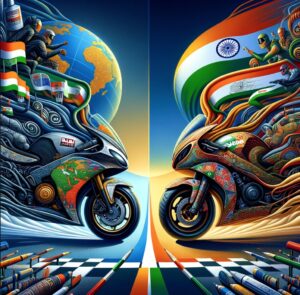In the competitive landscape of the Indian two-wheeler market, Bajaj Auto and Hero MotoCorp stand out as leading contenders. These companies not only dominate the domestic market but also have a significant presence internationally. This comparison delves into their financial health, stock performance over the past year, business models, segments, future strategies, strengths, weaknesses, profit formulas, investor bases, customer demographics, market capitalizations, and recent developments to offer a detailed analysis.
Financial Indicators and Stock Price Trends
Bajaj Auto is renowned for its diversified product range, including motorcycles, three-wheelers, and quadricycles. Financially, Bajaj Auto has maintained a robust balance sheet, with consistent revenue growth and profitability over the years. The company’s commitment to exports has helped it mitigate domestic market volatility. Stock prices for Bajaj Auto have shown resilience, with moderate fluctuations reflecting the company’s stability and growth in international markets.
Hero MotoCorp, the world’s largest manufacturer of motorcycles and scooters in terms of volume, boasts a dominant position in the Indian market. Hero’s financial indicators highlight its strong market penetration and operational efficiency. However, the stock has experienced some volatility, attributed to market share battles and evolving consumer preferences. Despite this, Hero MotoCorp’s vast dealership network and brand loyalty among consumers in rural and urban India remain its core strengths.
Business Models and Segments
Bajaj Auto’s business model is characterized by its emphasis on innovation and diversification. The company has strategically expanded its international footprint, making significant inroads into emerging markets. Bajaj’s focus on premium and sports segments, in collaboration with brands like KTM and Triumph, distinguishes it from competitors.
Hero MotoCorp’s business model centers on volume leadership and market penetration. The company has excelled in catering to the mass market segment, with products that emphasize durability, fuel efficiency, and affordability. Hero’s recent foray into electric vehicles (EVs) marks its strategic pivot towards sustainable mobility solutions.
Future Strategy, Strengths, and Weaknesses
Bajaj Auto plans to leverage its R&D capabilities to introduce innovative products and strengthen its position in the electric vehicle market. The company’s global presence and brand partnerships are significant strengths. However, its dependence on international markets exposes it to geopolitical risks and currency fluctuations.
Hero MotoCorp’s strategy focuses on expanding its EV portfolio and enhancing digital initiatives to improve customer experience. The company’s extensive dealer network and strong brand equity in the commuter segment are its foremost strengths. Conversely, its late entry into the premium and EV segments could be seen as a weakness in the face of shifting market dynamics.
Profit Formula, Investors, and Customers
Bajaj Auto’s profit formula hinges on its high-margin premium products and export-led growth. The company attracts investors looking for a blend of stability and international exposure in the two-wheeler sector.
Hero MotoCorp’s profitability is driven by its volume sales in the mass market segment. Its investor base comprises those with confidence in the company’s market leadership and penetration strategy in India and select international markets.
Market Capitalization and Recent Developments
As of the latest financial year, Bajaj Auto’s market capitalization reflects its robust financial health and promising growth prospects in domestic and international markets. Recent developments include strategic investments in electric mobility and expansion plans in Africa and Latin America.
Hero MotoCorp’s market capitalization, while influenced by short-term market volatilities, underscores its strong brand and market presence in India. The company’s notable developments include the launch of its EV brand and initiatives to strengthen its R&D capabilities for future mobility solutions.
Conclusion
Bajaj Auto and Hero MotoCorp are pivotal players in the two-wheeler industry, each with distinct strategies and strengths. Bajaj Auto’s diversified portfolio and international strategy contrast with Hero MotoCorp’s domestic dominance and volume-driven approach. Both companies are navigating the transition towards electric mobility, highlighting their commitment to innovation and sustainability.




